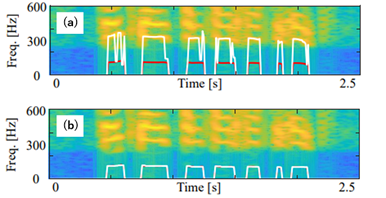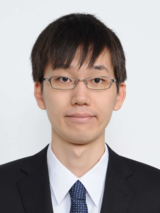

Diagnosis of voice condition from call audio
Toward the development of a dysarthria diagnostic system in telemedicine Yuya Hosoda
Assistant Professor Yuya Hosoda of the Center for IT-Based Education (CITE), Toyohashi University of Technology developed a method for estimating the pitch of vocal cord vibrations of humans from call audio. In this method, the pitch is estimated by integrating the feature quantities extracted from the amplitude and phase spectra of speech on the complex plane. Through experiments, we have demonstrated that the proposed method is not only efficient for calls where the frequency band is restricted by communication standards, but also works robustly in an environment with background noise.
Early diagnosis of dysarthria, which is an early symptom of neurodegenerative illnesses such as Parkinson's disease, can help to reduce the severity of such diseases. Dysarthria is characterized by tremors in the voice and disturbed breathing. Although clinical tests diagnose symptoms from the patient's voice, they are time consuming and labor intensive. Additionally, conducting face-to-face interviews in remote locations such as mountainous areas is difficult. Therefore, in this research, we aim to develop a system that automatically diagnoses dysarthria through telemedicine by performing ward rounds via communication devices.
In patients with dysarthria, abnormalities occur during vocalization wherein the voice is produced by vocal cord vibrations generated by air released from the lungs in the throat and oral cavity. In this study, our purpose is to estimate the vibration period (pitch) to diagnose the condition of these vocal cord vibrations. Prior to this new technique, pitch measurement methods that were robust against background noise were devised based on features related to the amplitude spectrum obtained by frequency analysis of speech. However, due to communication standards, call audio via telemedicine may lack some of the desired amplitude spectrum. Extracting feature quantities from an amplitude spectrum in such cases can lead to errors in pitch estimation.
In this research, we propose a method to extract additional feature quantities from the phase spectrum, a by-product of frequency analysis, in addition to the amplitude spectrum. Deriving a relational equation between the phase shift and pitch in the time and frequency directions, we have verified that pitch can be estimated by applying the observed phase shift to the relational equation. Based on this finding, we extracted new feature quantities from the phase spectrum to quantitatively evaluate the degree of fit to the relational equation. Finally, by integrating the feature quantities extracted from the amplitude spectrum on the complex plane, we compensated for the lack of feature quantities occurring in the pitch estimation of call audio while maintaining robustness against background noise.

The red and white lines indicate the measured and estimated values, respectively.
(a) Prior studies (b) Proposed method
The figure shows the pitch estimation results for a call audio. In previous studies that used only the amplitude spectrum, since the amount of information was reduced by band limitation, the pitch was estimated to be higher than the original value. However, in the proposed method, the pitch is accurately estimated from call audio using the feature quantities related to the amplitude and phase spectra. Further, the gross pitch error (GPE), an evaluation index that indicates the percentage of segments where errors occurred, improved to 9.5% in the proposed method, compared to 42.2% in the previous study. In addition, even for call audio with background noise, this method achieved a GPE of 15.2%, demonstrating robustness.
Although this study focused on pitch estimation to detect abnormalities in vocal cord vibrations, respiratory and oral abnormalities also cause dysarthria. To detect these symptoms, methods that extract feature quantities from the amplitude spectrum have been devised. However, the use of the phase spectrum has not been sufficiently validated. In the future, we will work on extracting relevant feature quantities from the phase spectra for the other cases as well. Further, by comprehensively analyzing these feature quantities, we aim to develop a dysarthria diagnostic system that can function effectively with telemedicine.
Reference
Yuya Hosoda, Arata Kawamura and Youji Iiguni, "Complex-Domain Pitch Estimation Algorithm for Narrowband Speech Signals," IEEE/ACM Transactions on Audio, Speech, and Language Processing, vol. 31, pp. 2067-2078, 2023.
https://doi.org/10.1109/TASLP.2023.3278488
通話音声から声の状態を診断
遠隔医療における構音障害診断システムの開発に向けて 細田 侑也豊橋技術科学大学IT活用教育センターの細田侑也助教は、人間の発声メカニズムにおける声帯振動のピッチを通話音声から推定する手法を開発しました。本手法では、音声の振幅及び位相スペクトルから抽出された特徴量を複素平面上で統合してピッチを推定します。実験では、通信規格で周波数帯域が制限されている通話音声に対しても有効であるだけでなく、背景雑音が付加された環境でも提案法が頑健に機能することを示しました。
パーキンソン病などの神経変性疾患の重症化を防止するためには、初期症状である構音障害を早期に診断することが望ましいです。構音障害の特徴として、声の震えや呼気の乱れが挙げられます。臨床検査では患者の声から症状を診断しますが、時間や労力がかかるだけでなく、山間部などの遠隔地での対面実施は困難です。そこで本研究では、通信機器を介して回診する遠隔医療により、自動的に構音障害を診断するシステムの開発を目指します。
構音障害の患者には、肺から放出された空気で生じる声帯振動が喉や口腔で共鳴して声が生成されるという発声メカニズムに異常が生じています。本研究では、声帯振動に関する状態を診断するために振動周期(ピッチ)を推定することを目的とします。これまでに、音声の周波数解析で得られる振幅スペクトルに関する特徴量に基づいて、背景雑音に対しても頑健なピッチ計測手法が考案されています。しかし、遠隔医療における通話音声では、通信規格により振幅スペクトルが一部欠如しています。そのため、情報量が削減されている振幅スペクトルから特徴量を抽出すると、ピッチを誤って推定する恐れがあります。
本研究では、振幅スペクトルに加えて、周波数解析の副産物である位相スペクトルから追加で特徴量を抽出する手法を提案しました。まず、時間方向及び周波数方向における位相のズレとピッチの関係式を導出して、観測された位相のズレを関係式に当てはめることで、ピッチを推定できることを検証しました。この知見に基づいて、関係式への当てはまり具合を定量的に評価する特徴量を新たに位相スペクトルから抽出しました。最終的に、振幅スペクトルから抽出される特徴量と複素平面上で統合することで、背景雑音に対する頑健性を維持しつつ、通話音声のピッチ推定で生じる特徴量不足を補いました。
図は、通話音声に対するピッチ推定結果を表します。振幅スペクトルのみを使用する先行研究では、帯域制限で情報量が削減されているため、本来よりも高くピッチを推定しました。一方で提案法では、振幅及び位相スペクトルに関する特徴量を用いて通話音声から正確にピッチを推定しました。また、誤差が生じた区間の割合を表す評価指標 Gross Pitch Error (GPE)では、先行研究の42.2%に対して、提案法は9.5%まで改善しました。加えて、背景雑音が付加された通話音声に対しても15.2%を達成して頑健性を示しました。
本研究では、声帯振動の異常を検出するためにピッチ推定に着目しましたが、呼吸器や口腔の異常も構音障害を引き起こす要因です。これらの症状を検出するために、振幅スペクトルから特徴量を抽出する手法が考案されていますが、位相スペクトルに関しては十分に検証されていません。将来的には、他の症例に関しても位相スペクトルから関連する特徴量を抽出することに取り組みます。また、それらの特徴量を総合的に解析することで、遠隔医療において有効に機能する構音障害診断システムを開発します。
Researcher Profile

| Name | Yuya Hosoda |
|---|---|
| Affiliation | Center for IT-Based Education (CITE) |
| Title | Assistant Professor |
| Fields of Research | Speech Signal Processing |
